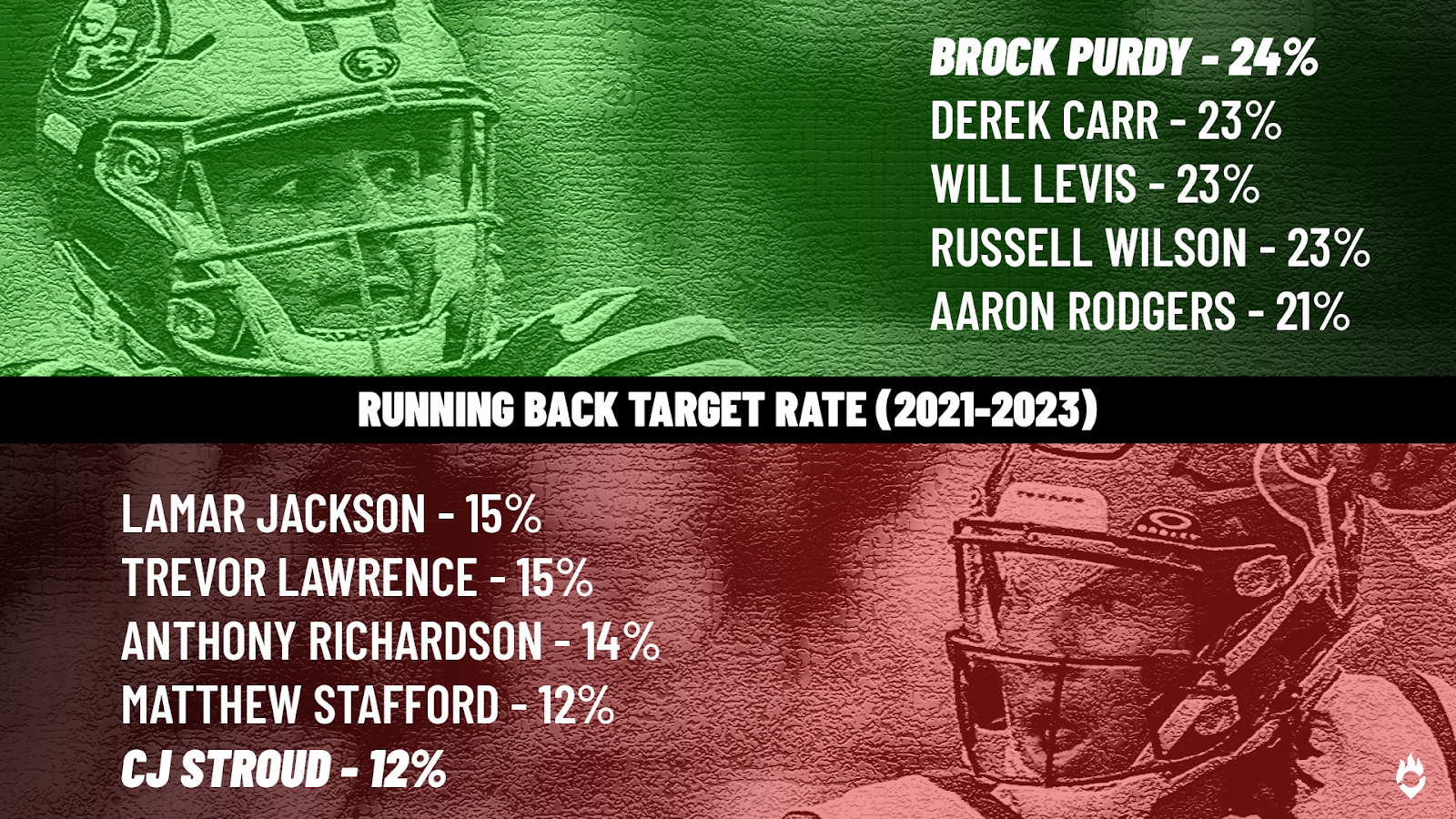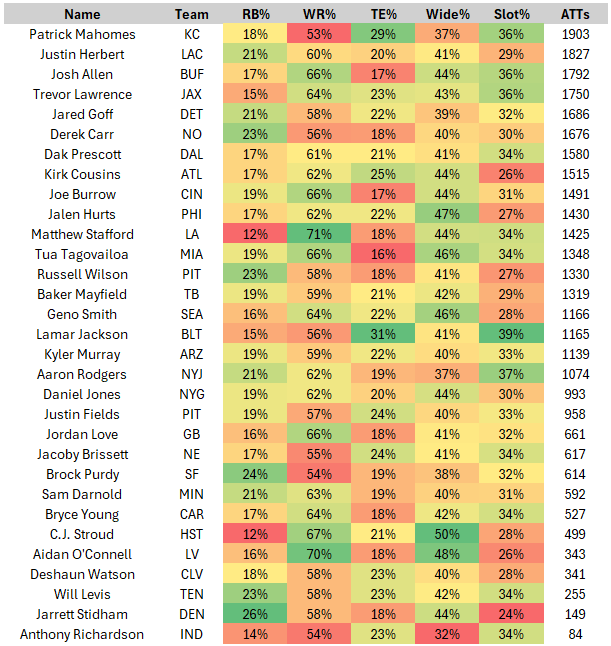A nearly unlimited number of factors are involved in predicting outcomes in fantasy football. A good starting place is often team or coaching tendencies, and while others and I are likely correct in the assumption that those tendencies play a larger role than QB tendencies, the QB is still the guy who determines who gets targeted on an individual play. Let Shane Steichen coach late-career Drew Brees, and I’ll guarantee you he targets Jonathan Taylor more often than Anthony Richardson.
With this in mind, I am going to dive into QB positional target tendencies for all potential 2024 starting QBs over a three-year sample size (2021-2023). Using this data, we can dial in on the QBs who target RBs, TEs, WRs, and the slot or outside at the highest/lowest rates and attempt to separate signal from noise to see what the most valuable trends are heading into 2024.
Two important points before we get started, this data will be heavily skewed by sample size and a QB’s surrounding cast. 2nd-year QBs like CJ Stroud or Anthony Richardson have thrown very few passes, and thus, their target tendencies are much more likely to be noise than, say, Jared Goff’s.
In regards to supporting cast, it should go without saying that if Travis Kelce is on your team, you are going to target TEs more because he’s a future hall of famer. I’ll do my best to acknowledge these factors in the analysis below.
Scroll to the bottom for a full chart of targets and percentages.
Running Backs
Bo Nix posted a 19% RB target share in his final college season, and I’d expect more of the same in Denver. Sean Payton offenses beg for checkdowns (top-8 in RB receptions in each of his last five seasons), so adding a QB already prone to RB throws is near-ideal for fantasy. And this is a spot where the backup QB (Jarrett Stidham) might target RBs at an even higher rate (league-leading 26% RB target rate in our sample). League-leading RB target shares are on the horizon for Denver, so I’m taking plenty of shots on Javonte Williams and Jaleel McLaughlin (whom I particularly like in best ball).
Alvin Kamara (18% target share) was Derek Carr’s 2nd favorite target in his 13 games last season. Kamara – who was last season’s RB5 in half PRR – is a near-lock to exceed his RB18 Underdog ADP on volume alone. Last season, Kamara ranked 3rd in XFP/G (18.4) despite the 12th-highest snap share (63%) because his pass-catching role was right behind Christian McCaffrey as the most valuable in the NFL (9.8 receiving FPG). I don’t view Kamara as the elite upside play he once was, but I’m fine taking him as a floor play in redraft or 12-player best ball leagues.
Will Levis posted the single-highest aDOT (11.1) last season, yet still managed to target RBs at a top-5 rate. Tennessee’s depressed pass rate (-3.2% pass rate over expectation, 5th-lowest) prevented those checkdowns from supercharging the fantasy value of this backfield, but that all figures to change under Brian Callahan. If Levis keeps up his RB target rate and Tennessee throws as much as the Bengals did last year, this backfield will jump from the 19th-most RB targets (99) to the 2nd-most (141.5). I’m buying as much Tyjae Spears as I can, and still trying to grab some shares of Tony Pollard.
Aaron Rodgers’ RB target rate of 21% over the last three seasons is identical to Zach Wilson’s (21%) and just below Trevor Siemien’s (26%) so I don’t expect a huge jump in targets for Breece Hall based on QB tendencies. Beyond offensive aptitude improving with Rodgers back, you could argue Hall could see a further increase in target share if Rodgers is simply worried about being hit. Nobody targeted RBs more than the aging Tom Brady from 2017-2021, and the final three seasons of Drew Brees’ career coincided with New Orleans ranking top-5 in RB targets. Rodgers is 40 years-old, fresh off an Achilles tear, and is in the twilight of his career – why would he sit in the pocket to take hits just to push the ball downfield when he knows he can throw to a top-5 RB and protect his body?
Rushing QBs target RBs less than their pocket-passing counterparts, and the presence of Anthony Richardson and Lamar Jackson at the bottom of RB target rate demonstrates that. Kyler Murray (19%) and Justin Fields (19%) are the only Konami Code QBs to rank in the top 10 in RB target rate over the last three seasons.
Following that thread, there likely won’t be a significant difference (4% in our sample) in the overall RB target rate between Fields and named starter Russell Wilson.
There has been little worry from the market that Joe Mixon (ADP: RB14) would be able to stick around his RB12 half-PPR finish from 2023. But CJ Stroud’s minuscule RB target rate is some cause for concern. If Mixon’s TPRR fell from the 0.20 he averaged in 2023 to the Texans’ 2023 backfield average of 0.14, he would have earned 20 fewer targets and finished as the half-PPR RB17. I’m not drafting Mixon much as I’m suspicious of any serious pass-catching upside here, but with so little talent behind him in an elite offense, Mixon could still beat cost as a workhorse mid-to-low-range RB1.
Kyren Williams posted only an 11% target share last year (20th among RBs) because the Rams had two elite pass catchers in Cooper Kupp and Puka Nacua. That WR duo combined to miss 5 games last season, and Williams posted two of his top-4 target shares of the season in those games. Nacua has a lengthy injury history and has been dealing with a minor knee injury during camp. And Kupp is 31 with a similarly lengthy injury history. Concerns over Blake Corum stealing reps are valid, but if either Kupp or Nacua misses time, the backfield target share will come up with a few points to help fill the void.
Slot Pass Catchers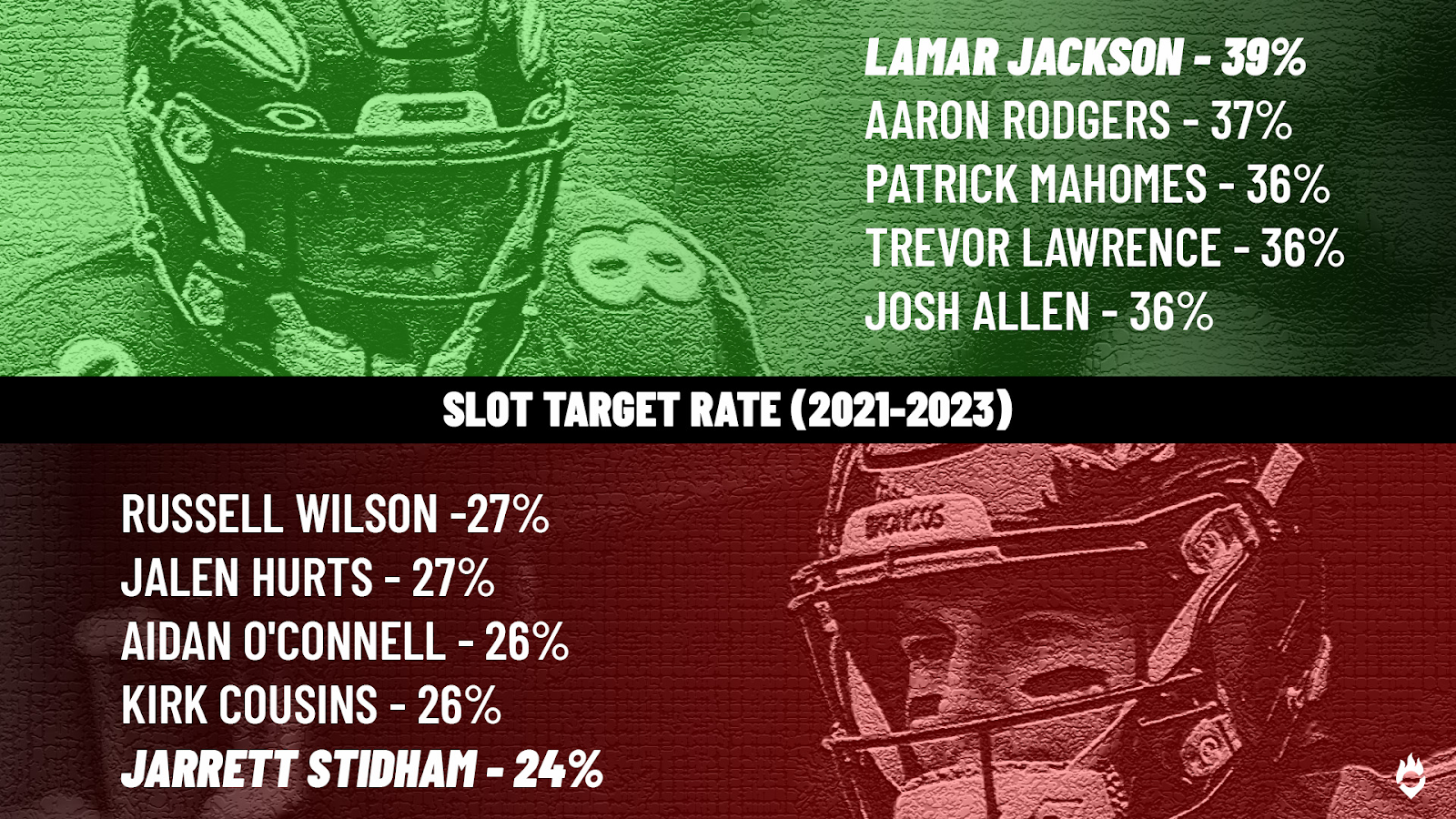
Aaron Rodgers’ affinity for the slot likely benefits Tyler Conklin, who ranked 2nd among returning Jets in slot rate (60%). I don’t see elite upside here, but Conklin is one of the most obvious TE values of the offseason – ranking as the TE14 in our projections by FPG (9.0) but the TE22 by DraftKings ADP.
No Buffalo player ran a higher percentage of their routes from the slot last season than Khalil Shakir (78%). Preseason usage suggests Shakir is competing for the same slot snaps as Curtis Samuel (who is currently dealing with turf toe and may not be ready for Week 1). A timeshare would tank the value of this slot role for any full-season formats, but if either player monopolizes the slot in Buffalo, we could be looking at a compelling value (as a staff, we prefer Shakir, who ranks highly in our separation metrics). Don’t forget, Samuel finished as the WR27 by FPG (14.1) in his most recent season with Bills’ OC Joe Brady (2020), ranking 3rd among WRs in touches per game (7.9).
Jalen Hurts’ slot target rate could be in for a dramatic shift with Kellen Moore now calling the plays. The question then becomes one of who benefits — the smart money is clearly on DeVonta Smith. Smith holds the PFF college-era record (2014-present) for YPRR from the slot (4.96). And since entering the league, he ranks 7th-best of 119 WRs in YPRR from the slot (2.48 vs. 1.66 on all other routes). AJ Brown ranks 28th (1.76). Smith is my favorite value among Eagles skill players.
Wide Pass Catchers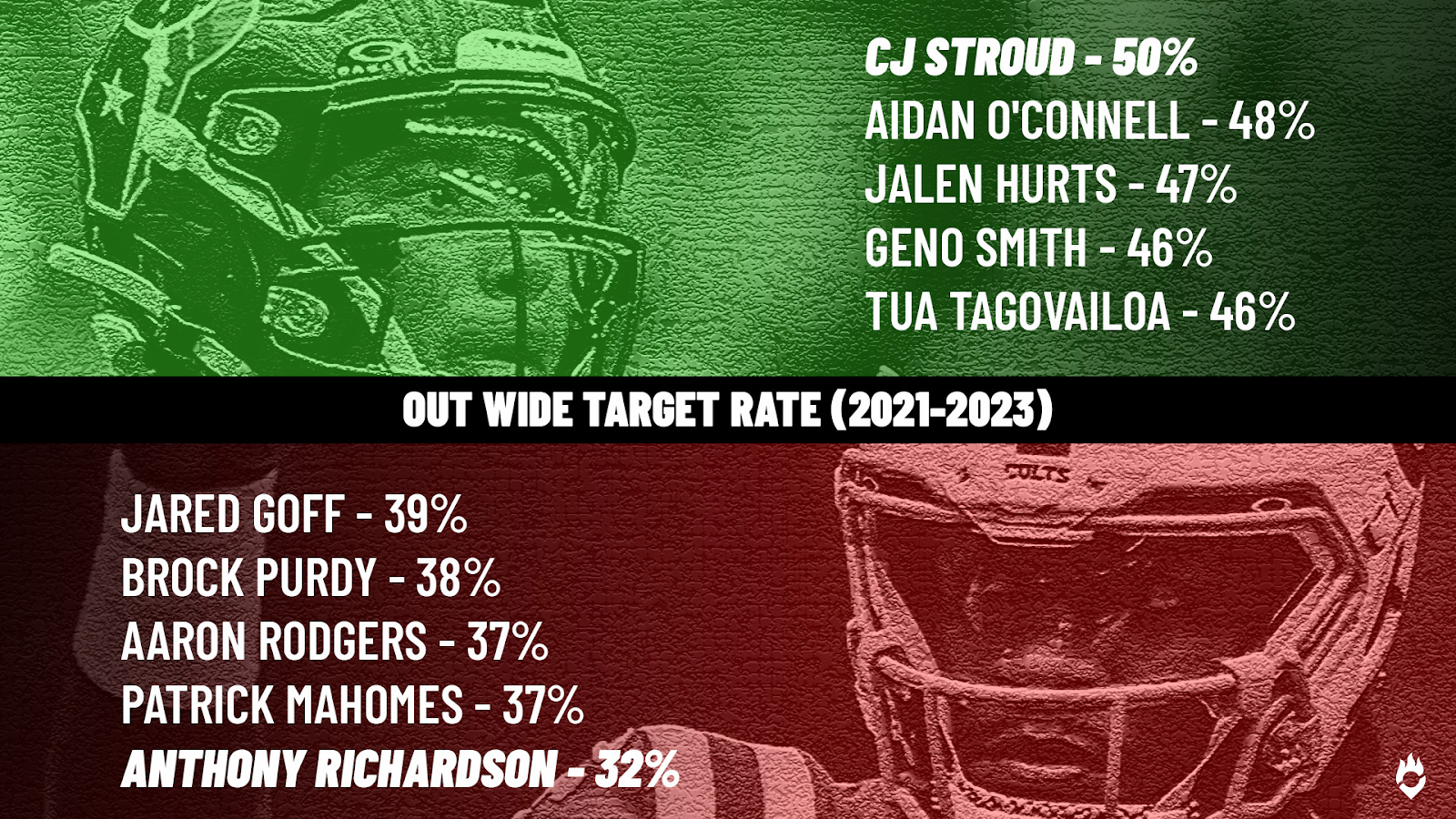
- Geno Smith’s aggressive targeting of outside pass-catchers obviously hurt Jaxon Smith-Njigba (69% slot rate), alongside the Seahawks’ unwillingness to even put Smith-Njigba on the field (71% route share). New Seahawks OC Ryan Grubb just got three WRs (Rome Odunze, Ja’Lynn Polk, and Jalen McMillan) drafted in Rounds 1, 2, and 3, so there is a chance a massive uptick in three WR sets massively boosts the fantasy output we see from Smith-Njigba. At the very least, Smith-Njigba is the type of prospect I want to take shots on as he enters year two – the 2nd-most common year for a WR to breakout.
Jaxon Smith-Njigba, 2023
— Fantasy Points Data (@FantasyPtsData) July 7, 2024
On 1st/2nd downs:
+ 62.5% route share (65th)
+ 13.9% first-read target share (69th)
On 3rd/4th downs:
+ 90.2% route share (15th)
+ 34.4% first-read target share (10th)!!!
Concept: new OC Ryan Grubb decides to use JSN on every down
- WRs playing primarily on the outside have struggled massively in Detroit. Josh Reynolds (7.6 FPG) led the Lions outside WRs last year to a WR69 finish, and DJ Chark (6.9 FPG) didn’t fair much better in 2022 (WR58). With no scheme or QB change in sight, this isn’t exactly encouraging for Jameson Williams (ADP: WR46) – who is somehow being drafted ahead of Josh Palmer (ADP: WR52) despite no guarantee of significant target volume. Spike-week potential keeps Williams viable in best ball formats, but I’m not chasing him elsewhere.
Tight Ends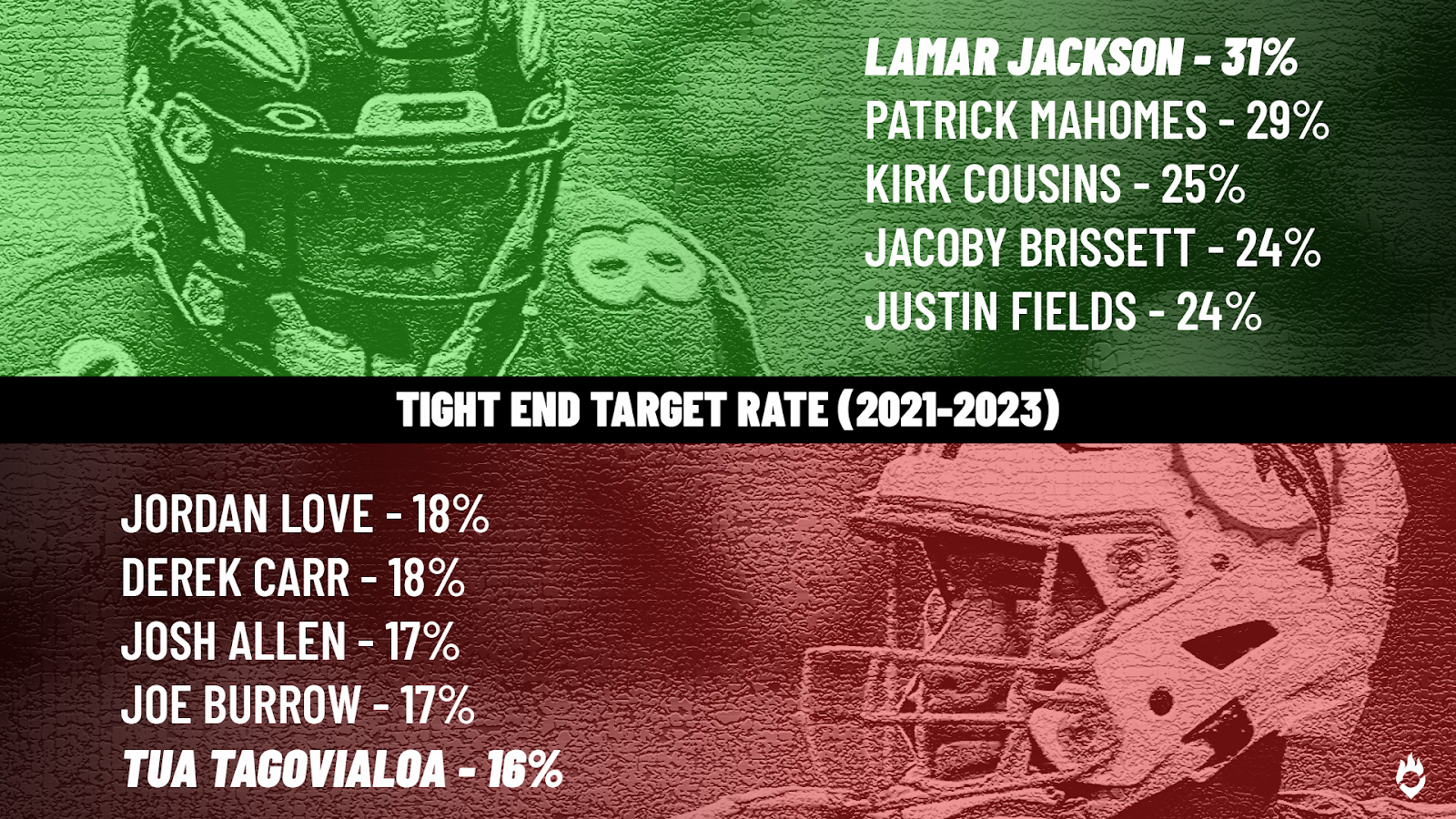
- Kirk Cousins aggressively targeting TEs can only be good news for Kyle Pitts. Over the past two seasons, Travis Kelce and Mark Andrews are the only TEs to have averaged more expected fantasy points per route run (XFP/RR) than Pitts. The primary issue for Pitts was never per-route usage but rather target quality and quantity. Over the last two seasons, the Vikings passing attack with Cousins under center has averaged +50% more catchable targets per game (30.1) than Atlanta (20.0). And new OC Zac Robinson is a near-lock to usher in a more pass-heavy offense. I’ll be taking as many shares of Pitts (a generational prospect who is only 23) as possible.
Atlanta's 2023 pass rate over expectation: -5.5% (last)
— Jake Tribbey (@JakeTribbey) July 31, 2024
PROE of every McVay disciple in 2023: +2.8% (11th-best in 2023) pic.twitter.com/IhIVBBbe9k
Derek Carr’s minimal TE target rate caps the upside of Juwan Johnson – but I still find myself taking a ton of Taysom Hill at cost (TE14) on DraftKings. Positional target tendencies don’t matter much when dealing with a positionless player like Hill. Per Nate Jahnke from PFF, Hill played on 65% of snaps with the New Orleans starters this preseason, seeing multiple snaps at RB, FB, slot WR, outside WR, and TE. Last season, Hill finished as the TE15 by FPG (9.0) despite earning more than 50% of snaps twice (40% snap share over the full season). On a per-snap basis, Hill was the 4th-most efficient TE in the league last year (0.3 fantasy points per snap). If he maintained a 65% snap share in the regular season, Hill would be looking at 12.9 FPG, which would have bested George Kittle for TE6 last year.
Our projections give Buffalo the 4th-biggest jump in TE target share (+2.7%), and the 5th-highest TE target share overall (26%) despite Josh Allen’s bottom-5 TE target rate. Still, this boost isn’t enough to present value at Dalton Kincaid’s inflated ADP (TE5). Last season, Kincaid averaged +6.8 more FPG without Dawson Knox on the field (14.2 FPG) than with him (7.2 FPG). Knox is still expected to be a big part of this TE rotation, and we need to acknowledge serious volume concerns. After OC Joe Brady took over, the Bills’ pass rate over expectation (PROE) dropped from +6.8% (3rd over the full season) to -2.7% (26th). A jump in raw targets is expected with Buffalo missing so much WR talent, but Kincaid beating ADP faces the serious headwinds of historic QB tendencies, sub-optimal TE rotations, and a run-first offense.


